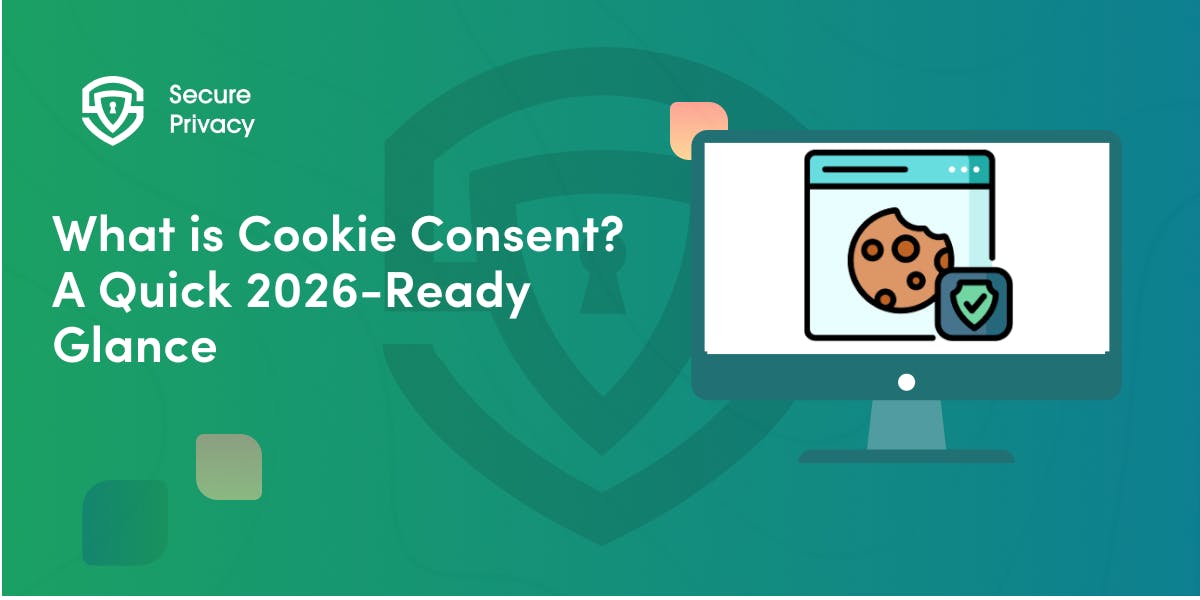Cookie Consent Best Practices: Getting your Website Compliant in 2025
Your website just lost another potential customer. Not because of your product, pricing, or user experience — but because your cookie banner frustrated them into clicking away. Sound familiar?
Cookie consent best practices have evolved far beyond simple pop-ups asking users to click "Accept." In 2025, your consent mechanism serves as the critical first impression of your commitment to user privacy. Get it wrong, and you risk regulatory fines, damaged trust, and abandoned sessions. Get it right, and you build credibility while maintaining full legal compliance.
This comprehensive guide walks you through implementing effective cookie consent mechanisms that satisfy GDPR, CCPA, and other regulations while respecting your users' time and attention. You'll discover proven design principles, technical implementation strategies, and optimization techniques that balance legal requirements with genuine user experience quality.
What Cookie Consent Actually Means for Your Website
Cookie consent represents your users' explicit permission to place tracking technologies on their devices. This permission isn't just a legal formality—it's a binding agreement that determines what data you can collect, how you can use it, and what happens when users say no.
The stakes have never been higher. Regulators across Europe, California, and beyond now examine consent mechanisms for manipulative design patterns that pressure users into acceptance. The Swedish Data Protection Authority recently issued formal notices against websites using visual tricks to favor "Accept" buttons, while France's CNIL has taken aggressive action against banners that make rejection unnecessarily difficult.
Your consent mechanism must achieve three objectives at once. First, collect legally valid consent that meets regulatory standards for being freely given, specific, informed, and unambiguous. Second, provide genuine user choice without manipulation or pressure. Third, maintain website functionality and user experience regardless of the consent decision.
Understanding the Legal Framework Behind Cookie Consent
GDPR establishes the most demanding requirements for cookie consent management across global privacy regulations going into 2026. The regulation requires explicit opt-in consent before placing any non-essential cookies. This means users must take affirmative action — clicking an "Accept" button counts, but pre-checked boxes or continued browsing do not.
The regulation requires specific consent options that let users accept some cookie categories while rejecting others. You cannot bundle consent for essential functionality cookies with optional marketing trackers. GDPR also prohibits cookie walls that block website access entirely for users who decline consent.
CCPA operates under different principles that emphasize notice and opt-out rather than opt-in consent. California residents must receive clear disclosure about data collection activities and prominent mechanisms to opt out of data sales or sharing. The "Do Not Sell or Share My Personal Information" link has become standard on websites targeting California users.
The practical challenge emerges when your website serves global audiences simultaneously. European visitors need opt-in consent mechanisms while California residents require opt-out controls. This necessitates sophisticated geo-targeting that presents appropriate interfaces based on user location and applicable legal frameworks.
Beyond GDPR and CCPA, dozens of other regulations worldwide impose cookie consent requirements going into 2026. Organizations operating internationally must implement systems flexible enough to accommodate multiple regulatory requirements without creating inconsistent user experiences.
Designing Cookie Banners That Users Actually Understand
Effective cookie consent banner design starts with equal visual prominence for accept and reject options. Your "Accept All" and "Reject All" buttons must be identical in size, color contrast, and positioning. Regulators specifically target designs where acceptance appears as a bold primary button while rejection hides as a subtle text link.
Clear language makes the difference between informed consent and confused acceptance. Avoid legal jargon like "legitimate interest processing" or "data controller obligations" that confuse average users. Instead, explain in straightforward terms what cookies do: "We use cookies to remember your preferences, analyze how you use our site, and show you relevant advertisements."
Your banner should present three clear pathways: immediate acceptance of all cookies for users comfortable with full tracking, immediate rejection of all optional cookies for privacy-focused users, and access to detailed settings for those who want specific control over cookie categories.
Non-intrusive placement balances visibility with user experience. Bottom banners typically work better than full-page overlays that block all content. However, the banner must remain visible and accessible—hiding it behind scroll requirements or making it dismissible through any click violates consent principles.
Mobile optimization requires special attention because smaller screens amplify design challenges. Touch-friendly button sizing, thumb-accessible placement, and simplified language become critical. Research shows mobile users accept cookies more readily than desktop users, creating ethical obligations to ensure mobile interfaces don't exploit context limitations.
Accessibility compliance has become a legal requirement alongside privacy regulations. Your cookie banner must work effectively with keyboard navigation, screen readers, and meet WCAG 2.2 standards for color contrast and focus indicators, and preferably IAB TCF 2.3 standards.
Implementing Technical Mechanisms That Block Cookies Before Consent
Prior blocking represents the technical foundation of GDPR cookie consent compliance. Your website must prevent all non-essential cookies from activating until users provide explicit consent. This includes third-party advertising pixels, analytics scripts, social media widgets, and any other tracking technologies beyond essential functionality cookies.
Many organizations use consent management platforms that automatically detect and block cookies across their web properties. These platforms analyze page code to identify tracking technologies, categorize them by purpose, and prevent activation until appropriate consent is obtained.
Cookie categorization enables detailed consent management by organizing trackers into functional groups. Essential cookies support core website operations like shopping carts and login sessions. Functional cookies enable enhanced features like language preferences or video playback. Analytics cookies measure website performance. Marketing cookies enable personalized advertising and social media sharing.
Each category needs clear explanations that help users make informed decisions. Vague descriptions like "improve user experience" don't provide meaningful information for consent decisions.
Consent documentation and audit trails protect your organization during regulatory investigations. Your system must record exactly when each user provided consent, which cookie categories they accepted, what information you disclosed, and how you presented choices.
Providing Easy Consent Withdrawal and Preference Management
Cookie consent isn't a one-time transaction — it's an ongoing relationship that users can modify at any time. GDPR explicitly requires that withdrawing consent must be as easy as providing it. If users can accept all cookies with a single click, they must be able to reject all cookies with equal simplicity.
Your preference management interface should be accessible from every page through a persistent link in your footer or privacy settings. Users shouldn't need to hunt through multiple menus or contact support to change their cookie preferences.
Implementing preference changes in real-time presents technical complexity. When users revoke consent for analytics cookies, those tracking scripts must stop executing immediately across all active sessions. When users accept marketing cookies they previously rejected, those capabilities should activate without requiring a page refresh.
Cross-device consent synchronization addresses the reality that users interact with your brand across multiple devices and platforms. Leading implementations now offer universal consent management that maintains consistent preferences across all touchpoints.
Optimizing Consent Rates Without Manipulative Design
Consent rate optimization walks a delicate ethical line between improving user experience and manipulating choices. Legitimate optimization focuses on clarity, transparency, and reducing friction for informed decision-making. Manipulative optimization employs dark patterns that exploit psychology to pressure users toward business-preferred outcomes.
Clear value propositions help users understand benefits they receive from accepting certain cookie categories. Explaining that analytics cookies help you identify and fix website problems frames consent as supporting better user experiences.
Strategic timing considers when users can best evaluate consent decisions. Prompting immediately upon site entry forces choices before users understand your content or value proposition. Delayed prompts that appear after initial engagement allow users to make informed decisions based on actual experience.
Privacy-friendly designs that genuinely respect user autonomy often result in lower acceptance rates than manipulative alternatives. Research shows that banners using equal prominence and clear reject options see only 6% acceptance for all cookies. This represents authentic user preference rather than manufactured consent through design manipulation.
Building long-term trust requires prioritizing genuine user choice over short-term conversion optimization. Users who feel manipulated into cookie acceptance develop negative associations with your brand.
Comparing Leading Cookie Consent Management Platforms
Selecting the right consent management platform determines implementation success and long-term compliance maintenance. Leading platforms offer automated cookie scanning that identifies tracking technologies across your digital properties. AI-powered categorization classifies cookies by purpose and legal basis. Real-time blocking prevents cookie activation until consent is obtained.
Integration capabilities vary significantly across platforms. Some offer seamless connections with popular tag management systems like Google Tag Manager. Others provide native integrations with major marketing platforms, analytics tools, and advertising networks.
Compliance coverage determines which regulations each platform supports effectively. Some specialize in GDPR compliance for European operations. Others focus on CCPA requirements for California residents. Comprehensive platforms offer multi-jurisdictional support that automatically presents appropriate consent interfaces based on user location.
Customization options range from basic banner templates to complete design control. Your choice should balance customization needs with implementation complexity.
Reporting and analytics features help you understand consent patterns and identify optimization opportunities. Advanced platforms track acceptance rates by cookie category, geographic region, device type, and traffic source.
Maintaining Compliance as Regulations Evolve
Cookie consent requirements continue evolving as regulators develop more sophisticated understanding of user interface psychology and data collection practices. The enforcement focus has shifted from technical compliance checkboxes to examining actual user experiences.
Dark pattern elimination has become a primary enforcement priority. Authorities now specifically target visual hierarchy manipulation where "Accept" buttons appear prominently while "Reject" options hide as subtle text links. Friction asymmetry that makes acceptance instant but rejection require multiple clicks violates informed consent principles.
Regular compliance audits help identify potential violations before they attract regulatory attention. Your audit process should examine consent banner design for dark patterns, review cookie blocking implementation, check preference management interfaces for accessibility issues, and analyze consent documentation.
Vendor monitoring ensures that third-party services don't introduce compliance risks through their own tracking technologies. Your vendor agreements should specify compliance responsibilities and require notification before changes to data collection practices.
Training programs ensure that everyone involved in your digital operations understands consent compliance responsibilities. Developers need technical knowledge about prior blocking implementation. Designers require awareness of dark pattern prohibitions. Marketers must understand the implications of consent choices for campaign effectiveness.
Building Future-Proof Cookie Consent Systems
Future-proofing your consent implementation requires architectural flexibility that accommodates emerging requirements without fundamental redesign. Regulations will continue evolving as legislators and regulators develop more nuanced understanding of digital privacy.
Modular architecture enables independent updates to different system components. Your cookie scanning mechanisms should upgrade without affecting user interface design. Consent storage systems should scale without requiring changes to preference management workflows.
API-first approaches provide integration flexibility as your technology stack evolves. When you adopt new marketing platforms, analytics tools, or advertising networks, API connections enable seamless consent enforcement across those systems.
Documentation practices ensure institutional knowledge survives personnel changes and organizational transitions. Comprehensive documentation should explain your consent architecture, detail implementation decisions, and provide troubleshooting guides.
Continuous monitoring systems provide early warning when issues emerge. Automated testing can verify that cookie blocking functions correctly across different browsers and devices. Compliance scanning can flag potential dark pattern issues before they attract regulatory attention.
Taking Action on Cookie Consent Best Practices
Cookie consent implementation represents a significant undertaking that requires coordination across legal, technical, design, and business teams. However, the investment pays dividends through reduced regulatory risk, enhanced user trust, and competitive differentiation in an increasingly privacy-conscious marketplace.
Start by auditing your current consent implementation against best practices outlined in this guide. Identify dark patterns that require immediate correction. Assess whether your cookie blocking actually prevents trackers from activating before consent. Evaluate accessibility compliance with keyboard navigation and screen reader support.
Prioritize fixes that address the most significant compliance risks. Equal prominence for accept and reject buttons should be your first correction if current designs favor acceptance. Prior blocking for non-essential cookies takes precedence over interface optimization.
Select appropriate tools that match your organizational capabilities and requirements. Small websites with straightforward tracking might implement adequate consent through carefully configured free platforms. Enterprise organizations with complex multi-jurisdictional operations typically require comprehensive commercial solutions.
Implement systematic processes for ongoing compliance maintenance. Regular audits identify emerging issues before they become regulatory problems. Vendor monitoring ensures third parties don't introduce new compliance risks.
Remember that cookie consent best practices ultimately serve the fundamental principle of respecting user autonomy over personal information. Technical compliance and regulatory requirements provide the framework, but genuine respect for user choice should guide every implementation decision. Organizations that embrace this perspective build lasting competitive advantages through enhanced trust, improved user relationships, and sustainable business practices that respect human dignity in the digital age.
Get Started For Free with the
#1 Cookie Consent Platform.
No credit card required

What is Cookie Consent? A Quick 2026-Ready Glance
Your website loads. Cookies track users. But without proper cookie consent, you're violating GDPR — risking fines up to €20 million or 4% of global revenue. Cookie consent is the legally required mechanism by which websites obtain explicit user approval before deploying non-essential tracking technologies. This requirement stems from GDPR Article 4(11) and the ePrivacy Directive, mandating that consent must be freely given, specific, informed, and unambiguous.
- Legal & News

DSAR Tools Explained: Best Software for Automating Privacy Requests
You're drowning in data subject access requests. Manual searches through dozens of systems miss regulatory deadlines and expose organizations to fines starting at $2,500 per violation. The solution? DSAR tools — purpose-built software that automates the entire process of responding to data subject access requests, from intake to delivery.
- Legal & News

IAB TCF 2.3 Explained: Requirements, Updates, and Implementation Guide (2026)
Your ad revenue dropped 40% overnight. Google stopped bidding on your inventory. Your DSP partners flagged your traffic as non-compliant. The culprit? An outdated TCF 2.2 consent string after the February 2026 enforcement deadline.
- Legal & News
- Cookie Consent
